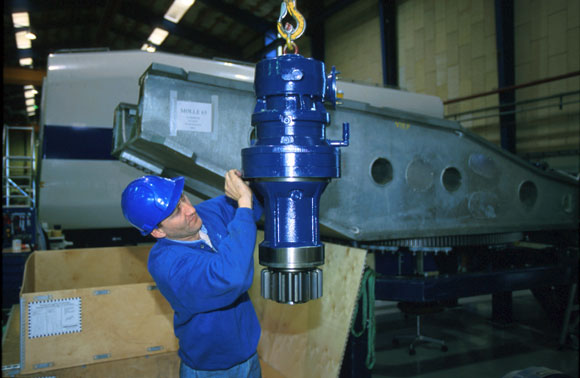
|
|
II.Turbines III.Yaw controller  I. Rotor blades I. Rotor blades______________________________________________________________ The rotor blades is composed by the blades and the hub placed in the top of tower. It captures the wind and transfers its power to the turbine.The hub is the part at the end of the axe, in the blades side.The hub of the rotor is attached to the low speed shaft of the wind turbine. On a modern wind turbine (1000 kW) each blade measures about 27 meters in length and is designed much like a wing of an aeroplane. 
 II. Turbines II. Turbines______________________________________________________________ A wind turbine has to use the wind power to produce electricity . When the wind turns the blades of a wind turbine , it spins a turbine inside a small generator to produce electricity , as a dynamo on a bike , used to keep the light of the bike switch on . It's a device who is converting the movement energy of the rotation of the blades in an electrical current. With the magnetic energy the turbine produce energy.It's used to give power to the generator of the wind turbine.   III. Yaw controller III. Yaw controller______________________________________________________________ The rotor should always face the wind so the wind turbine will generate as much electricity as possible. The yaw motor turns the nacelle so that the rotor faces the wind. Yaw controller is a mechanism which uses electric motors and gearboxes to keep the turbine yawed against the wind. It is composed by the yaw drive and the yaw motor . The sensors detect the direction of the wind and adjust the position of the turbine so that it is directed to the wind origine with the yaw motor and yaw drive .So the yaw motor turns the turbine by the yaw drive system as the instructions of the sensors. The yaw controller can't be directed exactly into wind, in which case some active control of the nacelle angle can be needed to maximize the energy capture. A yaw drive is usually required for start-up and for unwinding the pendant cable, it can as well be used for active yaw tracking. Free yaw has the advantage that it does not generate any yaw moments at the yaw bearing.It is usually necessary to have at least some yaw damping, in which case there will be a yaw moment at the bearing . In practice, most turbines do use active yaw control. A yaw error signal from the nacelle-mounted wind vane is then used to calculate a demand signal for the yaw actuator. Frequently the demand signal will simply be a command to yaw at a slow fixed rate in one or the other direction. The yaw vane signal must be heavily averaged, especially for upwind turbines where the vane is behind the rotor. Because of the slow response of the yaw control system, a simple dead-band controller is often sufficient. The yaw motor is switched on when the averaged yaw error exceeds a certain value, and switched off again after a certain time or when the nacelle has moved through a certain angle.  Informations from :
Informations from :wind power Power house kids by DECONINCK Yannick & JOUNIAUX Arthur |